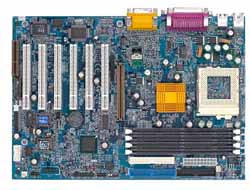Intel i815 / i815E Motherboard Roundup - August 2000
by Mike Andrawes on August 3, 2000 5:25 AM EST- Posted in
- Motherboards
|
Gigabyte 6OXM7E |
|
|
CPU Interface
|
Socket-370
|
|
Chipset
|
Intel i815E
|
|
Form Factor
|
ATX
|
|
Bus Speeds
|
55 / 60 / 66 / 68 / 70 / 75 / 66 / 83 / 90
100 / 103 / 112.5 / 115 / 120 / 125 / 128 / 130 133 / 137 / 140 / 145 / 150 / 153 |
|
Voltages Supported
|
Auto Detect
(10% CPU Over Voltage Jumper) |
|
Memory Slots
|
4 168-pin DIMM Slots
|
|
Expansion Slots
|
1 AGP Slot
6 PCI Slots (4 Full Length) 1 CNR Slot (Shared) 0 ISA Slots |
|
Onboard Audio
|
Sigmatel
STAC9708T AC 97 CODEC
Creative CT5880 PCI (optional) |
|
BIOS
|
Award Modular BIOS 6.00PG
Gigabyte DualBIOS |
Overclocking is not something that Gigabyte has pushed much in the past, offering only a handful of FSB speeds on a completely jumpered setup. Times are changing with the 6OXM7E, however, thanks to the inclusion of Gigabyte's Easy Tune III software overclocking utility and the removal of all FSB related jumpers.
Easy Tune III can tweak FSB speeds automatically until the system becomes unstable, and then back off a bit, or you can go into advanced mode and do the dirty work yourself. Advanced mode reports PCI and Memory speeds so you know exactly what you'll be setting the system to. As you scroll through the available bus speeds, you'll notice that they seem to jump around a bit. Well, they're sorted by FSB:SDRAM:PCI ratio first, then by the actual FSB. That means you'll be able to adjust all the appropriate ratios right from within Windows as you're adjusting the FSB.
Unfortunately, since it only runs under Windows, users of all other operating systems are out of luck. We definitely still prefer a BIOS or even jumper based solution for the maximum flexibility, but this is certainly easier for the novice. We also wish that Gigabyte would add separate controls for the FSB:SDRAM:PCI and AGP ratios, as well as CPU core voltage tweaking to Easy Tune III. More and higher FSB settings would also be nice. Fortunately, a "CPU Over Voltage" jumper is available on the motherboard for boosting Vcore by 10%.
Gigabyte is one of two manufacturers that included 4 DIMM slots in this roundup. As we explained earlier, the i82815 GMCH only supports 6 rows of memory, so if you want to use all 4 DIMM slots, two of the DIMM's must be single sided. While this may potentially confuse some people and cause a couple headaches, it does offer additional memory expansion flexibility. However, even with 3 DIMM's, this Gigabyte board had to drop back to PC100 memory speeds in order to remain stable. Even with just one PC133 DIMM, we had to drop back to CAS 3 memory timings to get decent stability.
Gigabyte's DualBIOS protection is back once again. Basically you get a second BIOS chip that acts as a backup in case the primary chip is corrupted. The nice thing about Gigabyte's version of all this is that it's fully automated, in that it will boot the backup chip if the first is corrupt without any user intervention. Our previous problems with DualBIOS revolved around the fact that it made it unnecessarily complicated to flash the BIOS with an update. Well now Gigabyte is offering @BIOS, a software utility that will go to the web, check for BIOS updates, and flash the BIOS - all within Windows 9x/NT/2000. It's easy to use and will be critical for Windows Millennium Edition and 2000 users who don't have a true DOS prompt with which to perform these tasks.
One of the more unique features of the 6OXM7E is the optional Smart Card Reader, made possible by the ITE IT8712F-A I/O controller chip. While Smart Cards are not too popular in the US, they are in many other parts of the world and this integration could save you a few bucks over buying a complete add-on solution.
We also see Gigabyte's AGP retention mechanism and a complete set of expansion slots on the 6OXM7E.











0 Comments
View All Comments